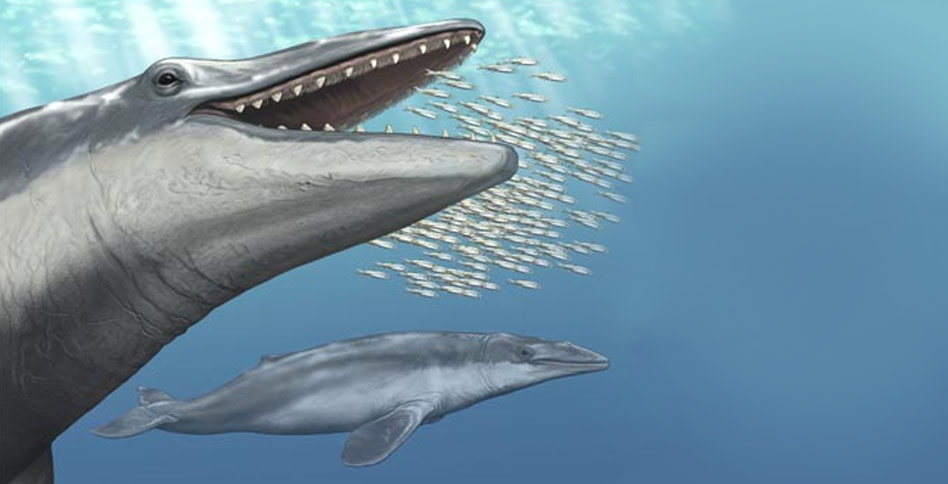
Aetiocetus weltoni
Age: 24-28 million years old, Oligocene Epoch
Range: Aetiocetus weltoni has only been recovered from deposits in coastal Oregon, indicating that it formerly inhabited the Eastern North Pacific Ocean. A closely related species (Aetiocetus polydentatus) is known from the Oligocene of Japan.
Size: Based on the skull of Aetiocetus, limited postcranial evidence from this species, and comparison with the basilosaurid cetacean Dorudon, Aetiocetus would have been about 3-3.5 meters long (10-11 feet).
Anatomy: In many respects Aetiocetus would have resembled some modern baleen whales, such as in having a wide, triangular, and flattened snout as well as a loose mandibular symphysis. In living baleen whales, the mandibles are joined at the front by a flexible ligament, which permits a larger gape that is useful for filter feeding. Fossil evidence suggests that Aetiocetus had this specialization, however unlike modern baleen whales, Aetiocetus retained a full set of teeth, its nose was positioned farther forward on its snout, and it was quite small in size. Most interestingly, a recent study discovered arterial grooves on the palate of Aetiocetus. These occur in modern baleen whales and allow arteries to supply blood and nutrients to the ever-growing baleen racks, which are made of a similar material as fingernails (keratin). Modern whales use baleen to filter out food from large quantities of seawater and/or bottom sediments. The available evidence suggests that Aetiocetus weltoni may havepossessed teeth and baleen at the same time, representing an important transitional state in baleen whale evolution.
Locomotion: Although parts of the skeleton of Aetiocetus weltoni are known, details of the skeleton have not been published. However, earlier cetaceans were already fully marine, likely possessed tail flukes, and had forelimbs developed into a hydrofoil-like flipper. We can infer that Aetiocetus retained these aquatic specializations that are also shared by all modern cetaceans, presumably their common ancestor, and all descendants of this common ancestor (including Aetiocetus).
Sensory Abilities: Aetiocetus is similar to some archaeocete cetaceans like Dorudon in possessing relatively large eye sockets, which suggest that Aetiocetus had well developed vision, potentially aiding pursuit and capture of single prey items. The lower jaw of Aetiocetus has a large hole for a pad of fat, which in modern toothed whales serves to channel underwater sounds into the middle and inner ear. This indicates that Aetiocetus was well equipped for hearing in the marine environment.
Diet: The diet of Aetiocetus is a contentious subject due to its unique position in the evolutionary history of baleen whales. Wear facets on its teeth and large eye sockets suggest that it fed on active, individual prey items such as fish. However, the possible presence of baleen suggests that Aetiocetus alsomay have employed some form of filter feeding, like modern baleen whales. As mentioned above, the lower jaw exhibits an unusual combination of features. The jaw joint (or "chin") is not fused, and a flexible ligament most likely joined the two sides of the jaw. Modern baleen whales have this ligament, and it allows the jaws to expand sideways. The size and position of the muscle attachment areas on the skull suggest that Aetiocetus had the same features that permit rapid snapping of the jaws like earlier basilosaurid cetaceans, such as Dorudon. While modern baleen whales are frequently described as feeding on krill (a type of small crustacean), many feed on schools of fish as well, and it is possible that Aetiocetus preyed upon single fish and on schools. It is also feasible that whatever 'protobaleen' was present, it may also have simply functioned as an additional structure to secure struggling, slippery fish.
Author: Robert Boessenecker
References Consulted: Barnes, L.G., Kimura, M., Furusawa, H., and H. Sawamura. 1995. Classification and distribution of Oligocene Aetiocetidae (Mammalia; Cetacea; Mysticeti) from western North America and Japan. The Island Arc 3:392-431.
Deméré, T.A., and A. Berta. 2008. Skull anatomy of the Oligocene toothed mysticete Aetiocetus weltoni (Mammalia; Cetacea): implications for mysticete evolution and functional anatomy. Zoological Journal of the Linnean Society 154:308-352.
Deméré, T.A., McGowan, M.R., Berta, A., and J. Gatesy. 2008. Morphological and molecular evidence for a stepwise evolutionary transition from teeth to baleen in mysticete whales. Systematic Biology 57:15-37.